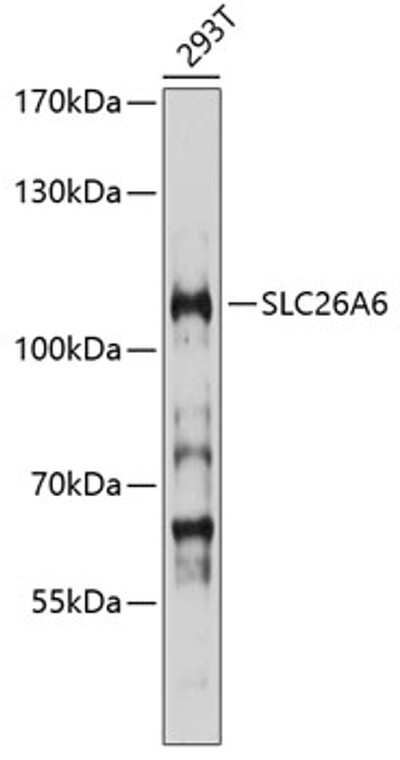| Host: |
Rabbit |
| Applications: |
WB |
| Reactivity: |
Human |
| Note: |
STRICTLY FOR FURTHER SCIENTIFIC RESEARCH USE ONLY (RUO). MUST NOT TO BE USED IN DIAGNOSTIC OR THERAPEUTIC APPLICATIONS. |
| Short Description: |
Rabbit polyclonal antibody anti-SLC26A6 (509-758) is suitable for use in Western Blot research applications. |
| Clonality: |
Polyclonal |
| Conjugation: |
Unconjugated |
| Isotype: |
IgG |
| Formulation: |
PBS with 0.02% Sodium Azide, 50% Glycerol, pH7.3. |
| Purification: |
Affinity purification |
| Dilution Range: |
WB 1:500-1:2000 |
| Storage Instruction: |
Store at-20°C for up to 1 year from the date of receipt, and avoid repeat freeze-thaw cycles. |
| Gene Symbol: |
SLC26A6 |
| Gene ID: |
65010 |
| Uniprot ID: |
S26A6_HUMAN |
| Immunogen Region: |
509-758 |
| Immunogen: |
Recombinant fusion protein containing a sequence corresponding to amino acids 509-758 of human SLC26A6 (NP_599025.2). |
| Immunogen Sequence: |
QMPHYSVLGQVPDTDIYRDV AEYSEAKEVRGVKVFRSSAT VYFANAEFYSDALKQRCGVD VDFLISQKKKLLKKQEQLKL KQLQKEEKLRKQAASPKGAS VSINVNTSLEDMRSNNVEDC KMMVSSGDKMEDATANGQED SKAPDGSTLKALGLPQPDFH SLILDLGALSFVDTVCLKSL KNIFHDFREIEVEVYMAACH SPVVSQLEAGHFFDASITKK HLFASVHDAVTFALQHPRP |
| Tissue Specificity | Ubiquitous. Highest levels in kidney and pancreas. Lower expression in heart, skeletal muscle, liver and placenta. Also found in lung and brain. Isoform 4: Ubiquitously expressed. Highest levels expressed in the kidney and pancreas. Isoform 5: Expressed weakly in placenta, lung, liver and pancreas. Isoform 6: Expressed in heart, brain, placenta, lung, liver, kidney, pancreas, spleen, thymus, prostate, testis and ovary. |
| Post Translational Modifications | Isoform 4: Phosphorylated on serine residues by PKC.the phosphorylation disrupts interaction with carbonic anhydrase CA2 and reduces bicarbonate transport activity in a phorbol myristate acetate (PMA)-induced manner. Glycosylation at Asn-167 and Asn-172 positively regulates its chloride oxalate exchanger activity. |
| Function | Apical membrane anion-exchanger with wide epithelial distribution that plays a role as a component of the pH buffering system for maintaining acid-base homeostasis. Acts as a versatile DIDS-sensitive inorganic and organic anion transporter that mediates the uptake of monovalent anions like chloride, bicarbonate, formate and hydroxyl ion and divalent anions like sulfate and oxalate. Functions in multiple exchange modes involving pairs of these anions, which include chloride-bicarbonate, chloride-oxalate, oxalate-formate, oxalate-sulfate and chloride-formate exchange. Apical membrane chloride-bicarbonate exchanger that mediates luminal chloride absorption and bicarbonate secretion by the small intestinal brush border membrane and contributes to intracellular pH regulation in the duodenal upper villous epithelium during proton-coupled peptide absorption, possibly by providing a bicarbonate import pathway. Mediates also intestinal chloride absorption and oxalate secretion, thereby preventing hyperoxaluria and calcium oxalate urolithiasis. Transepithelial oxalate secretion, chloride-formate, chloride-oxalate and chloride-bicarbonate transport activities in the duodenum are inhibited by PKC activation in a calcium-independent manner. The apical membrane chloride-bicarbonate exchanger provides also a major route for fluid and bicarbonate secretion into the proximal tubules of the kidney as well as into the proximal part of the interlobular pancreatic ductal tree, where it mediates electrogenic chloride-bicarbonate exchange with a chloride-bicarbonate stoichiometry of 1:2, and hence will dilute and alkalinize protein-rich acinar secretion. Mediates also the transcellular sulfate absorption and oxalate secretion across the apical membrane in the duodenum and the formate ion efflux at the apical brush border of cells in the proximal tubules of kidney. Plays a role in sperm capacitation by increasing intracellular pH. Isoform 4: Apical membrane chloride-bicarbonate exchanger. Its association with carbonic anhydrase CA2 forms a bicarbonate transport metabolon.hence maximizes the local concentration of bicarbonate at the transporter site. |
| Protein Name | Solute Carrier Family 26 Member 6Anion Exchange TransporterPendrin-Like Protein 1Pendrin-L1 |
| Database Links | Reactome: R-HSA-427601 |
| Cellular Localisation | Cell MembraneMulti-Pass Membrane ProteinApical Cell MembraneCytoplasmic Vesicle MembraneMicrosomeLocalized In Sperm MembranesColocalizes With Cftr At The Midpiece Of Sperm TailLocalizes To The Apical Membrane Brush Border Of Epithelial Cells In The Proximal Tubules Of KidneyOf Enterocytes Of The Small Intestine And Of Gastric Parietal Cells In The StomachIsoform 4: Cell MembraneBasolateral Cell MembraneLocalizes To The Apical And Basolateral Surfaces Of Tubular Wall Cells In Kidney And In The Brush Border Of Pancreatic Duct CellsColocalized With Ca2 At The Surface Of The Cell Membrane In Order To Form A Bicarbonate Transport MetabolonColocalization Is Reduced In Phorbol Myristate Acetate (Pma)-Induced CellsMay Be Translocated From The Cytosolic Surface Of The Cell Membrane To The Intracellular Space By Pkc In Phorbol Myristate Acetate (Pma)-Induced CellsIsoform 5: Cell MembraneIsoform 6: Cell Membrane |
| Alternative Antibody Names | Anti-Solute Carrier Family 26 Member 6 antibodyAnti-Anion Exchange Transporter antibodyAnti-Pendrin-Like Protein 1 antibodyAnti-Pendrin-L1 antibodyAnti-SLC26A6 antibody |
Information sourced from Uniprot.org
12 months for antibodies. 6 months for ELISA Kits. Please see website T&Cs for further guidance







